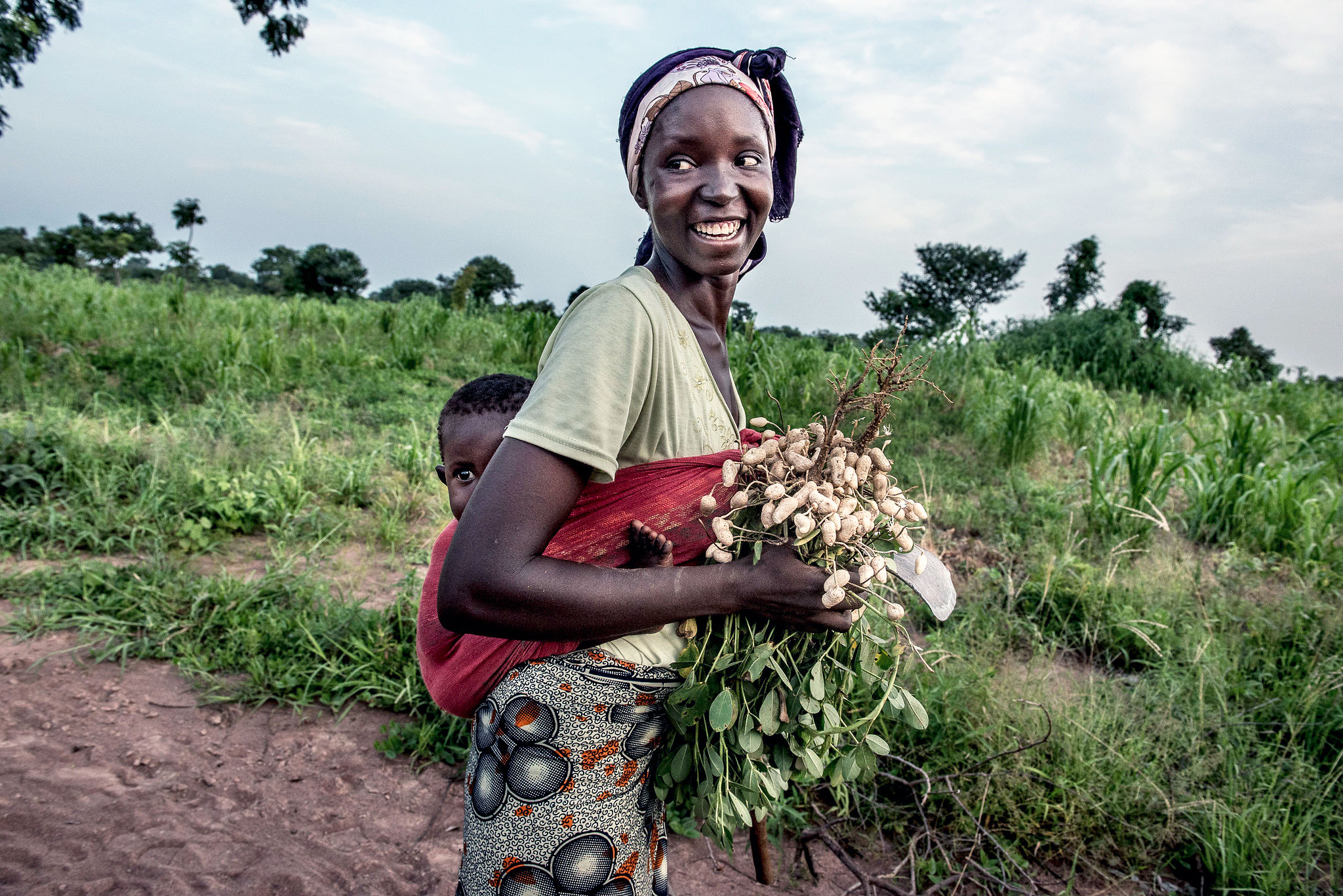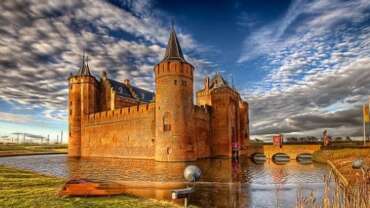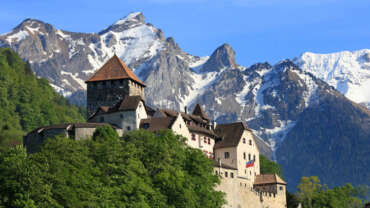Chad - Welcome you everytime!
Chad, landlocked state in north-central Africa. The country’s terrain is that of a shallow basin that rises gradually from the Lake Chad area in the west and is rimmed by mountains to the north, east, and south. Natural irrigation is limited to the Chari and Logone rivers and their tributaries, which flow from the southeast into Lake Chad. The capital, N’Djamena (formerly Fort-Lamy), is almost 1,000 miles (1,600 km) by road from the western African coastal ports.
Although it is the fifth largest country on the continent, Chad—much of the northern part of which lies in the Sahara—has a population density of only about 20 persons per square mile (8 persons per square km). Most of the population lives by agriculture; cotton is grown in the south, and cattle are raised in the central region. Chad joined the ranks of oil-producing countries in 2003, raising hopes that the revenues generated would improve the country’s economic situation.
History of Chad
The region of the eastern Sahara and Sudan from Fezzan, Bilma, and Chad in the west to the Nile valley in the east was well peopled in Neolithic times, as discovered sites attest. Probably typical of the earliest populations were the dark-skinned cave dwellers described by Herodotus as inhabiting the country south of Fezzan. The ethnographic history of the region is that of gradual modification of this basic stock by the continual infiltration of nomadic and increasingly Arabicized white African elements, entering from the north via Fezzan and Tibesti and, especially after the 14th century, from the Nile valley via Darfur. According to legend, the country around Lake Chad was originally occupied by the Sao. This vanished people is probably represented today by the Kotoko, in whose country, along the banks of the Logone and Chari, was unearthed in the 1950s a medieval culture notable for work in terra-cotta and bronze.
The relatively large and politically sophisticated kingdoms of the central Sudan were the creation of Saharan Imazighen (Berbers), drawn southward by their continuous search for pasturage and easily able to impose their hegemony on the fragmentary indigenous societies of agriculturalists. This process was intensified by the expansion of Islam. There are indications of a large immigration of pagan Imazighen into the central Sudan early in the 8th century.
From the 16th to the 19th century
The most important of these states, Kanem-Bornu, which was at the height of its power in the later 16th century, owed its preeminence to its command of the southern terminus of the trans-Saharan trade route to Tripoli.
Products of the Islamized Sudanic culture diffused from Kanem were the kingdoms of Bagirmi and Ouaddaï, which emerged in the early years of the 17th century out of the process of conversion to Islam. In the 18th century the Arab dynasty of Ouaddaï was able to throw off the suzerainty of Darfur and extend its territories by the conquest of eastern Kanem. Slave raiding at the expense of animist populations to the south constituted an important element in the prosperity of all these Muslim states. In the 19th century, however, they were in full decline, torn by wars and internecine feuds. In the years 1883–93 they all fell to the Sudanese adventurer Rābiḥ az-Zubayr.
French administration
By this time the partition of Africa among the European powers was entering its final phase. Rābiḥ was overthrown in 1900, and the traditional Kanembu dynasty was reestablished under French protection. Chad became part of the federation of French Equatorial Africa in 1910. The pacification of the whole area of the present republic was barely completed by 1914, and between the wars French rule was unprogressive. A pact between Italy and France that would have ceded the Aozou Strip to Italian-ruled Libya was never ratified by the French National Assembly, but it provided a pretext for Libya to seize the territory in 1973. During World War II Chad gave unhesitating support to the Free French cause. After 1945 the territory shared in the constitutional advance of French Equatorial Africa. In 1946 it became an overseas territory of the French Republic.
Independence of Chad
A large measure of autonomy was conceded under the constitutional law of 1957, when the first territorial government was formed by Gabriel Lisette, a West Indian who had become the leader of the Chad Progressive Party (PPT). An autonomous republic within the French Community was proclaimed in November 1958, and complete independence in the restructured community was attained on Aug. 11, 1960. The country’s stability was endangered by tensions between the Black and often Christian populations of the more economically progressive southwest and the conservative, Muslim, nonblack leadership of the old feudal states of the north, and its problems were further complicated by Libyan involvement.
Lisette was removed by an associate more acceptable to some of the opposition, N’Garta (François) Tombalbaye, a southern trade union leader, who became the first president of the republic. In March 1961 Tombalbaye achieved a fusion of the PPT with the principal opposition party, the National African Party (PNA), to form a new Union for the Progress of Chad. An alleged conspiracy by Muslim elements, however, led in 1963 to the dissolution of the National Assembly, a brief state of emergency, and the arrest of the leading ministers formerly associated with the PNA. Only government candidates ran in the new elections in December 1963, ushering in the one-party state.
People of Chad
The population of Chad presents a tapestry composed of different languages, peoples, and religions that is remarkable even amid the variety of Africa. The degree of variety encountered in Chad underscores the significance of the region as a crossroads of linguistic, social, and cultural interchange.
Languages
More than 100 different languages and dialects are spoken in the country. Although many of these languages are imperfectly recorded, they may be divided into the following 12 groupings: (1) the Sara-Bongo-Bagirmi group, representing languages spoken by about one million people in southern and central Chad, (2) the Mundang-Tuburi-Mbum languages, which are spoken by several hundred thousand people in southwestern Chad, (3) the Chado-Hamitic group, which is related to the Hausa spoken in Nigeria, (4) the Kanembu-Zaghawa languages, spoken in the north, mostly by nomads, (5) the Maba group, spoken in the vicinity of Abéché and throughout the Ouaddaï region of eastern Chad, (6) the Tama languages, spoken in the Abéché, Adré, Goz Béïda, and Am Dam regions, (7) Daju, spoken in the area of Goz Béïda and Am Dam, (8) some languages of the Central African groups, particularly Sango (also the lingua franca of the Central African Republic), which are spoken in the south, (9) the Bua group, spoken in southern and central Chad, (10) the Somrai group, spoken in western and central Chad, and (11) Mimi and (12) Fur, both spoken in the extreme east.
In addition to this rich assortment, Arabic is also spoken in various forms and is one of the two official languages of the country. The dialects spoken by the nomadic Arabs differ from the tongue spoken by settled Arabs. A simplified Arabic is spoken in towns and markets; its diffusion is linked to that of Islam.
French is the other official language, and it is used in communications and in instruction as well, although the national radio network also broadcasts in Arabic, Sara Madjingay, Tuburi, and Mundang. While a regional form of French, showing local linguistic and environmental peculiarities, is spoken widely in the towns, its penetration into the countryside is uneven. Its use is closely linked to the development of education.
Ethnic groups
As might be expected, the linguistic variety reflects an ethnic composition of great complexity. A general classification may nevertheless be made, again in terms of the three regions of Chad.
In the wet and dry tropical zone, the Sara group forms a significant element of the population in the central parts of the Chari and Logone river basins. The Laka and Mbum peoples live to the west of the Sara groups and, like the Gula and Tumak of the Goundi area, are culturally distinct from their Sara neighbours. Along the banks of the Chari and Logone rivers, and in the region between the two rivers, are found the Tangale peoples.
Among the inhabitants of the semiarid tropical zone are the Barma of Bagirmi, the founders of the kingdom of the same name; they are surrounded by groups of Kanuri, Fulani, Hausa, and Arabs, many of whom have come from outside Chad itself. Along the lower courses of the Logone and Chari rivers are the Kotoko, who are supposedly descended from the ancient Sao population that formerly lived in the region. The Yedina (Buduma) and Kuri inhabit the Lake Chad region and, in the Kanem area, are associated with the Kanembu and Tunjur, who are of Arabic origin. All of these groups are sedentary and coexist with Daza, Kreda, and Arab nomads. The Hadjeray (of the Guera Massif) and Abou Telfân are composed of refugee populations who, living on their mountainous terrain, have resisted various invasions. On the plains surrounding the Hadjeray are the Bulala, Kuka, and the Midogo, who are sedentary peoples. In the eastern region of Ouaddaï live the Maba, among whom the Kado once formed an aristocracy. They constitute a nucleus surrounded by a host of other groups who, while possessing their own languages, nevertheless constitute a distinct cultural unit. The Tama to the north and the Daju to the south have formed their own separate sultanates. Throughout the Ouaddaï region are found groups of nomadic Arabs, who are also found in other parts of south central Chad. Despite their widespread diffusion, these Arabs represent a single ethnic group composed of a multitude of tribes. In Kanem other Arabs, mostly of Libyan origin, are also found.
In the northern Chad regions of Tibesti, Borkou, and Ennedi the population is composed of Black nomads. Their dialects are related to those of the Kanembu and Kanuri.
Religion of Chad
About three-fifths of the population are Sunni Muslim. The great majority of Muslims are found in the north and east of Chad. Islamization in Kanem came very early and was followed by the conversion to Islam of the major political entities of the region, such as the sultanates of Wadai, Bagirmi, and Fitri, and—more recently—the Saharan region. Islam is well established in most major towns and wherever Arab populations are found. It has attracted a wide variety of ethnic groups and has forged a certain unity which, however, has not resulted in the complete elimination of various local practices and customs.
Animists account for almost one-fifth of the population. Animism flourishes in the southern part of the country and in the mountainous regions of Guera. The various traditional religions provide a strong basis for cohesion in the villages where they are practiced. Despite a diversity of beliefs, a widespread common feature is the socioreligious initiation of young people into adult society.
Slightly more than one-fifth of the population are Christian, primarily Protestant or Roman Catholic. In Chad, as elsewhere, Christian missionary work has not affected the Muslim population; it has been directed toward the animist populations in the cities in the western regions south of the Chari River and in parts of the central uplands area.
Cultural Life of Chad
With its rich variety of peoples and languages, Chad possesses a valuable cultural heritage. The country is famed for the rock paintings of its ancient inhabitants, which can be found in abundance in the caves and rock overhangs of the Tibesti Mountains. Especially well-preserved sites are located at Gonoa and Zouar. Terra-cotta heads and figures found at Gaou, near Lake Chad, are believed to be relics of the early Sao civilization.
The country’s capital, N’Djamena, has a cosmopolitan air, with lively sidewalk cafés, small bars, and discotheques. These venues are sometimes used for a modern homegrown custom called pari-match, in which a private party is staged in a rented bar or public place, with the proceeds from alcohol sales going to the host to help pay for school tuition, home repairs, and other household expenses. The city is also known for its bazaars, which sell locally produced traditional goods and crafts such as textiles, camel-hair carpets and jackets, brass ornaments, and pottery. Also located in the capital is the National Museum, which houses prehistoric and traditional artifacts.
Chad has a small but well-regarded music industry. Modern Chadian musicians combine Western-influenced pop with traditional songs and instruments. Important indigenous instruments include a three-stringed lute featuring a bowl-shaped sound box covered with camel skin. By custom, only men are allowed to play these lutes. One of Chad’s most popular recording artists is the ballad singer Clément Masdongar, who has earned a following in the French-speaking countries of Africa and made several appearances at European musical festivals. Tibesti, a Chadian dance-music group, has also appeared internationally.
The local people of Chad have long enjoyed traditional contests of strength and skill. In the south footraces have often figured in the coming-of-age rites of several groups, with courses extending to a hundred miles and more. Such races have also popularly accompanied cattle-driving festivals and other celebrations. In the hotter, drier north, camel races, archery competitions, and wrestling matches mark traditional wintertime festivals, which are still observed alongside Muslim holidays.
More modern competitive sports such as football (soccer) and basketball are also popular throughout Chad, but intramural matches are rare, owing largely to the lack of travel funds and the impassability of Chad’s mostly dirt roads for much of the year. As a result, Chadians have not been able to field teams for many regional competitions, nor have they been able to gain the experience that comes from playing against a variety of teams. Chad made its Olympic debut at the 1964 Tokyo Games, but it has not yet won an Olympic medal.
Attractions & Places in Chad

A visit to Chad is not for the fainthearted. The country has been described as extreme in a continent that is full of destinations that will leave you out of your comfort zone. The country is certainly one that will leave you with memories, good and bad, that you will never forget.
Currently conflict in the country has made it simply to unsafe to visit but even in times of peace; this is a country for the travel hardened adventurer. Finding a comfortable hotel to spend a night is difficult, finding a road that is safe to travel on is even more so. The heat can often be unbearable with temperatures regularly exceeding 40 degrees Celsius. Oh and don’t forget that the police and military here are corrupt and will ask you for “gifts” as negotiation.
You may find yourself asking “well, why would anyone want to visit Chad?”. The answer could be the stunning terrain of the Sahara Desert which is some of the most oddly beautiful in the world, or the answer could be the animals that live in the Zakouma National Park. In all likelyhood however the reason for visiting a country like Chad is simply to experience what life is like in one of the most hostile and poorest parts of the world. A trip to Chad is far from a holiday but more of a life lesson.






